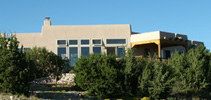Go Green with Sun Power for Sustainable Living
Passive Solar Heating and Cooling for a Healthy Home
Active Solar Generating Alternative Energy
As early as the Romans and Anasazi Indians, man was aware that by orienting his home south, towards the sun, he could let the heat of the day in by opening animal-skin shutters and doors. By closing them, he could hold that heat in through the night. That is the basis of today’s passive solar design.
There are three techniques used for heat collection in a passive solar home:
Direct Gain, or the construction of a glass south wall that admits light directly into a room so the heat may be absorbed into the floor and walls. This is an efficient system, but in the middle of winter, the rooms heated this way can fade furniture and be uncomfortably bright.
Greenhouses, or rooms dedicated to the admission and storage of heat. These rooms are often perfect for the propagation of plants and are generally vented to let the stored heat into the house.
Trombe wall, is a masonry wall behind glass on the south side of a house. The sun passes through the glass and falls directly upon the storage wall. This heat is then admitted to the house by conduction, when heat radiates through the wall into the house, or by convection, when a vent is placed at the top and bottom of the mass wall allowing heated air to circulate into the house.
Passive Cooling
As summer arrives, one notices a change in the angle of the sun. Through careful design of overhangs on the south side of a solar house, the rays of the sun can be excluded at any predetermined date. With the sun blocked, the home works in reverse, rather than absorbing heat from sunlight during the day, the thermal mass gives off heat at night, keeping the interior cool during the day.
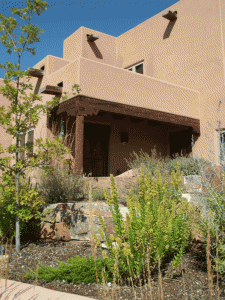
Active Solar Homes
The state of the art in sustainable homes that a working family can afford is the LEED (Leadership in Energy and Environmental Design) and BGNM (Build Green New Mexico) certified homes. Ranked in Silver, Gold and Platinum classifications with Platinum being a true Zero Energy Home with Photo Electric Panels to attain net zero energy use. These new certified designs are inspected during construction and tested after completion with a pressurization test called a “Blower Door Test” to make sure there are no leaks. Properly built these homes provide comfort, durability, healthy air quality and dramatically reduced energy costs. As these designs have evolved we have found that they can be built for little more than a conventional Low Efficiency house.
Whole House Ventilation
As LEED homes have become tighter and better insulated thy are becoming nearly airtight not allowing smells from cooking and other vapors to escape impacting inside air quality. New whole house ventilators, exchange the air in a home 4 or 5 times a day while recovering heat in the winter and cool in the summer as the air is exchanged. These systems come equipped with HEPA filters that remove dust and pollens. Nearly silent and energy efficient the Whole House Ventilator is a must have in a modern certified Green Home.
Solar Cooling
As summer arrives, one notices a change in the angle of the sun. Through careful design of overhangs on the south side of a solar house, the rays of the sun can be excluded at any predetermined date. With the sun blocked, the thermal gain works the opposite of how it works in winter; rather that absorbing heat from sunlight, the house absorbs heat from the atmosphere, keeping the interior cool during the day. The heat absorbed by the outside walls is radiated into the house at night, keeping the house comfortable when temperatures outside are moderate.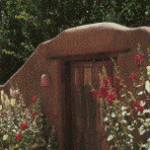
Passive Solar Homes have evolved since their inception in the late 60s. Alan Hoffman has been in the for front of Passive Solar design working to make solar heating invisible and comfortable for the residents. In New Mexico cooling is even a greater problem than heating, so he has worked to perfect Passive Cooling.
Water Use
New Mexico is situated just north of the Mexican border with Santa Fe nestled in the foothills of the Rocky Mountains at an elevation of 7,000 feet. This high desert averages 13 inches of precipitation per year. With a total population of just over a million, New Mexico has sufficient water for its citizens, but the time to consider water conservation is now. The County of Santa Fe has already begun to conserve water for the future. County officials believe that any family can prosper on 1/4 of an acre-foot of water per year. That equals 223 gallons of water per day. There is a community in Santa Fe that has proven that a family can use ½ this amount of water with no effect on their Quality of life. For living a comfortable life within these water constraints, the County requires the following innovations:
• Water-Saving Toilets
• Water-Saving Showers
• Natural Landscaping and Drip Irrigation
Water-Saving Toilets
The average toilet uses approximately 4 gallons per flush. A family of three that uses the toilet 12 times per day expends 48 gallons. A water saving toilet uses approximately 1.5 gallons per flush, or 18 gallons per day for a savings of 30 gallons per day, or 7.5% of daily use.
Water-Saving Showers
The average shower runs at just under 5 gallons per minute. The average family of three, which showers for 30 to 40 minutes total, uses 140 to 180 gallons per day. Showers are the greatest use of domestic water. A showerhead using 2.5 gallons of water per minute reduces use by 75 to 100 gallons per day; this is a savings of up to 80 gallons per day, almost 30% of total use.
Natural Landscaping and Water Reclamation
In many other places in the country, large, lawns cover great portions of residential areas. In this semiarid climate, large lawns are quite rare; in fact, homes on large lots in the Santa Fe area are often surrounded by the junipers and piñon pines that have been there for hundreds of years. A large piñon may well be 300 years old, growing slowly in response to the climate. There are many advantages to natural landscaping. Besides the fact that natural landscaping uses no potable water, you also never have to cut the lawn. We have learned that that smaller garden close to the home surrounded by a wall can create a microclimate that is more moist and fertile than the area outside the wall. Irrigation for these areas is required and can be provided by water reclamation systems both big and small.
Water Reclamation and reuse for irrigation can dramatically reduce the demand for potable water demand. A modern reclamation facility treats all the wastewater from a home including the so-called black water. The resulting effluent can be near a potable standard wit BOD under 10 and is filtered to 10 microns. Drip irrigation from wastewater reclamation is the best way to create a lush garden area with trees, shrubs, vegetable gardens, and even small lawns while using no potable water.
If we in New Mexico use our resources wisely, we can make the desert bloom for many generations to come.
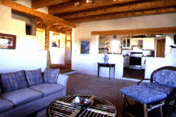
101 Coyote Ridge Road was designed and built by Alan Hoffman in 1989. This two-story home was the fourth in a series of prototypes.
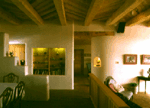
17 Via Brisa was designed and built by Alan Hoffman in 1991 as the fifth in a series of Passive Solar heated homes utilizing Direct Gain, Greenhouse and Trombe Wall heating systems. The house also utilized Thermo Siphon Cooling system.
